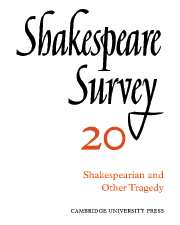Book contents
- Frontmatter
- Shakespeare, Fletcher and Baroque Tragedy
- Seneca and the Elizabethans: A Case-study in ‘Influence’
- George Chapman: Tragedy and the Providential View of History
- Critical Disagreement about Oedipus and Hamlet
- Shakespeare’s Thematic Modes of Speech: ‘Richard II’ to ‘Henry V’
- Anarchy and Order in ‘Richard III’ and ‘King John’
- The Staging of Parody and Parallels in ‘I Henry IV’
- Shakespeare’s Unnecessary Characters
- Walter Whiter’s Notes on Shakespeare
- Shakespeare’s ‘Romeo and Juliet’: Its Spanish Source
- The Grieves Shakespearian Scene Designs
- Shakespeare on the Modern Stage: Past Significance and Present Meaning
- Shakespeare in Brazil
- Recent Shakespeare Performances in Romania
- Shakespeare, the Twentieth Century and ‘Behaviourism’
- The Year's Contributions to Shakespearian Study 1 Critical Studies
- 2 Shakespeare’s Life, Times and Stage
- 3 Textual Studies
- Index
- Plate section
Recent Shakespeare Performances in Romania
Published online by Cambridge University Press: 28 March 2007
- Frontmatter
- Shakespeare, Fletcher and Baroque Tragedy
- Seneca and the Elizabethans: A Case-study in ‘Influence’
- George Chapman: Tragedy and the Providential View of History
- Critical Disagreement about Oedipus and Hamlet
- Shakespeare’s Thematic Modes of Speech: ‘Richard II’ to ‘Henry V’
- Anarchy and Order in ‘Richard III’ and ‘King John’
- The Staging of Parody and Parallels in ‘I Henry IV’
- Shakespeare’s Unnecessary Characters
- Walter Whiter’s Notes on Shakespeare
- Shakespeare’s ‘Romeo and Juliet’: Its Spanish Source
- The Grieves Shakespearian Scene Designs
- Shakespeare on the Modern Stage: Past Significance and Present Meaning
- Shakespeare in Brazil
- Recent Shakespeare Performances in Romania
- Shakespeare, the Twentieth Century and ‘Behaviourism’
- The Year's Contributions to Shakespearian Study 1 Critical Studies
- 2 Shakespeare’s Life, Times and Stage
- 3 Textual Studies
- Index
- Plate section
Summary
The celebration of the 400th anniversary of Shakespeare’s birth and of the 350 years from his death occasioned various manifestations in Romania which showed the great interest of audiences and readers for the creations of the dramatist who continues to speak profoundly to mankind. The plays performed reveal, at the same time, interesting new ways to comprehend and to evaluate the work of ‘the only Shake-scene’ so vividly present in our age.
The Shakespearian productions of the last two years (1964-6) cannot be looked upon as an exceptional moment in Shakespeare's destiny in our country; his plays have been performed, almost without interruption, for the last hundred years, and in 1912 our great poet, Tudor Arghezi, could write, with great reason—at the end of a captivating competition between three interpreters of the past—'Hamlet is indeed an old friend of the Bucharest playgoer'. But the present is of special interest because it reveals a tendency manifested, especially in the last two decades: that of working towards an entire and deep knowledge of Shakespeare's plays and, also, of increasing their popularity with the large mass of spectators. Certainly, the modern mass media—the channel of the radio and above all TV—assure the performances an audience that Shakespeare did not dream of, but I am referring especially to performances in conditions intended by Shakespeare: within the 'wooden O', in a theatre that allows the playgoer intimate contact with the living personage 'that struts and frets his hour upon the stage'. The last two years carried on the process of spreading the knowledge of Shakespeare through the intermediary of a large network of National and State Theatres.
- Type
- Chapter
- Information
- Shakespeare Survey , pp. 125 - 132Publisher: Cambridge University PressPrint publication year: 1967

